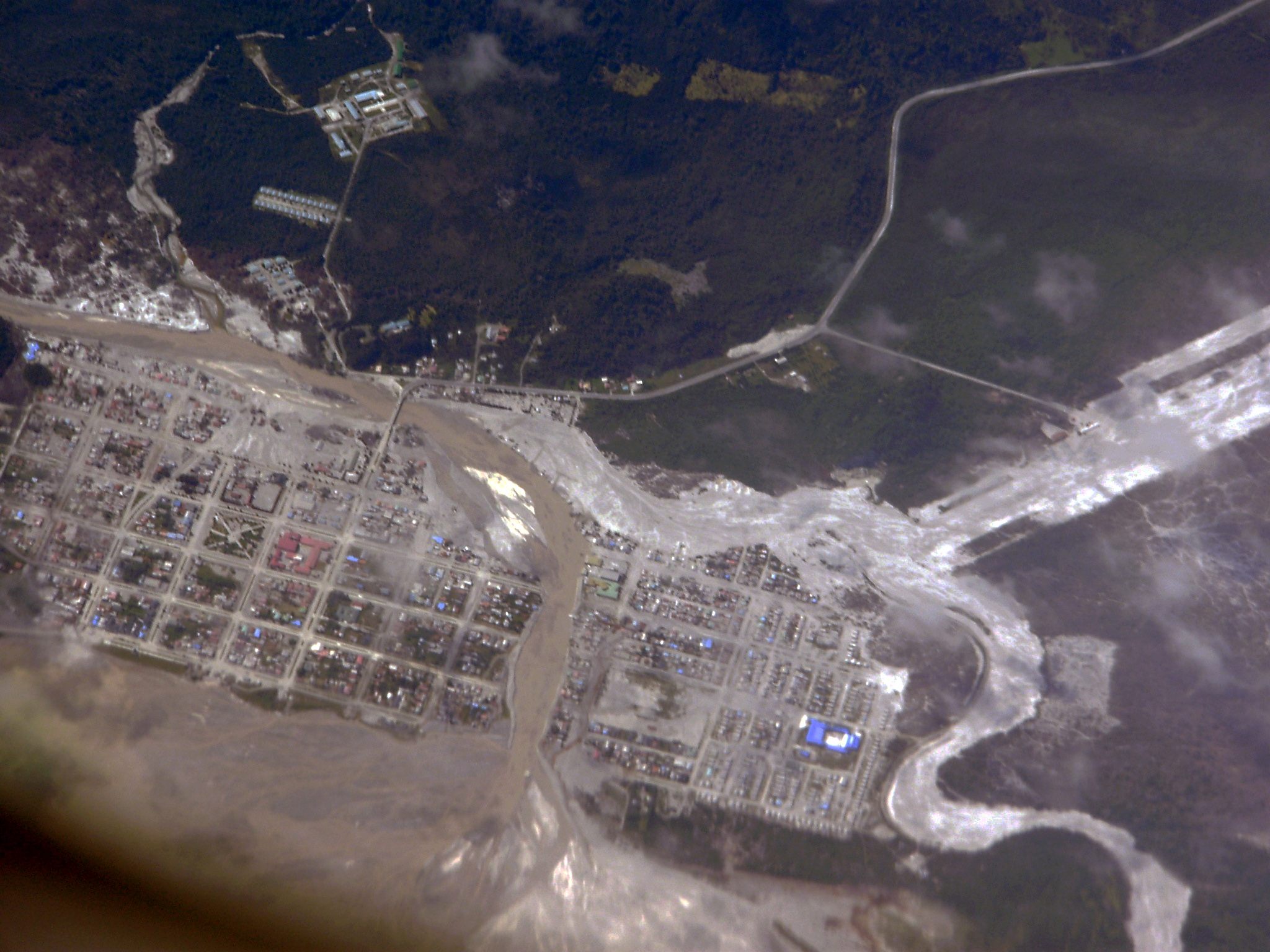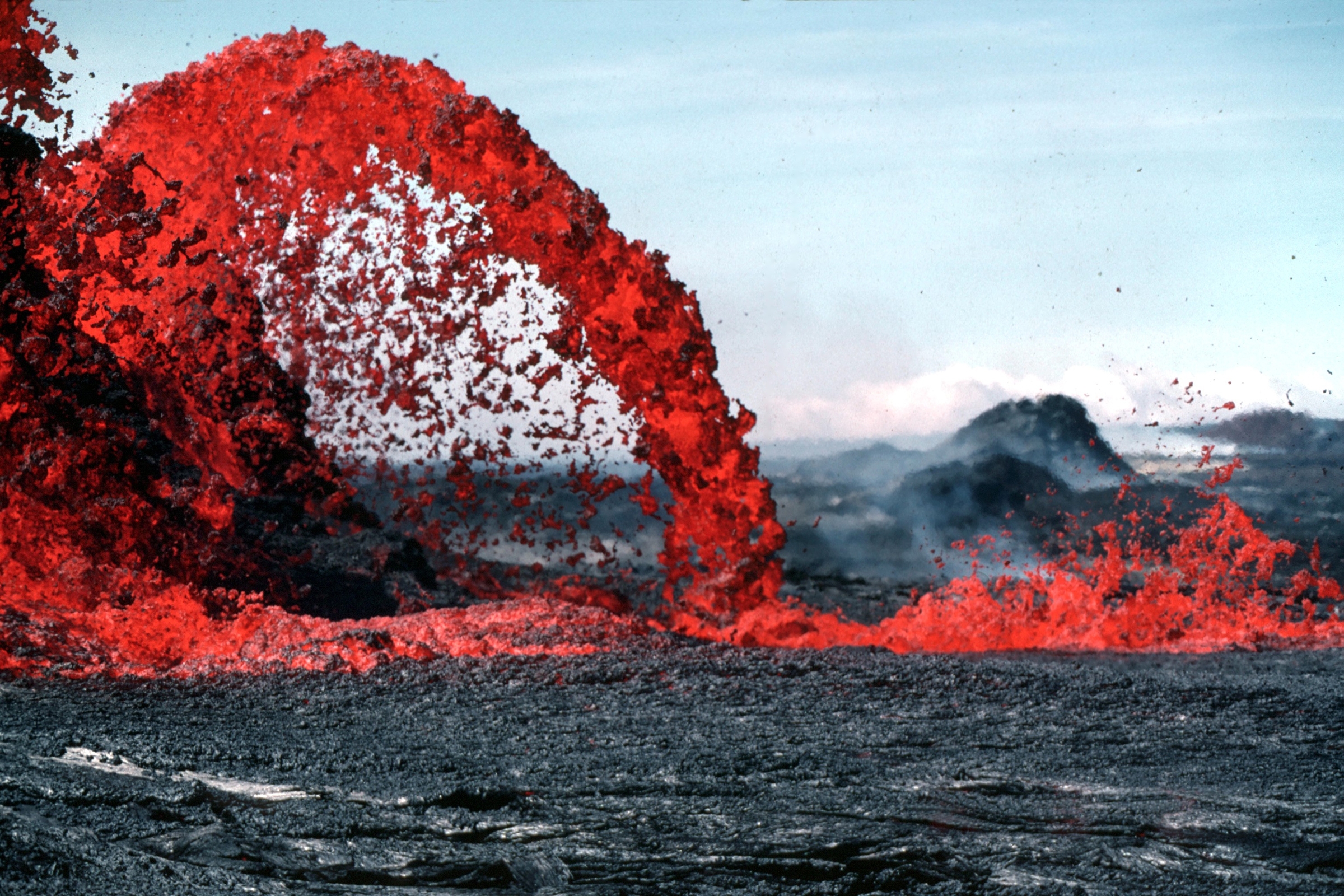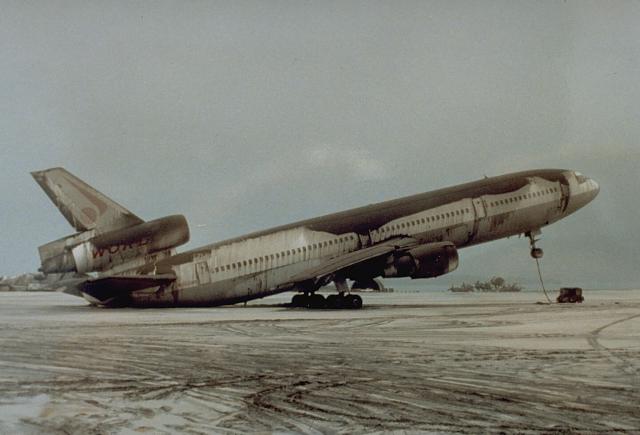|
Chaitén (volcano)
Chaitén is a volcanic caldera in diameter, west of the elongated ice-capped Michinmahuida volcano and northeast of the town of Chaitén, near the Gulf of Corcovado in southern Chile. The most recent eruptive phase of the volcano erupted on 2008. Originally, radiocarbon dating of older tephra from the volcano suggested that its last previous eruption was in 7420 BC ± 75 years. However, recent studies have found that the volcano is more active than thought. According to the Global Volcanism Program, its last eruption was in 2011. The caldera rim reaches above sea level. Before the current eruption, it was mostly filled by a rhyolite obsidian lava dome that reached a height of , partly devoid of vegetation. Two small lakes occupied the caldera floor on the west and north sides of the lava dome. The translucent grey obsidian which had erupted from the volcano was used by pre-Columbian cultures as a raw material for artifacts and has been found as far away as to the ... [...More Info...] [...Related Items...] OR: [Wikipedia] [Google] [Baidu] |
Chaitén
Chaitén (, ) is a Chilean town, commune and former capital of the Palena Province in Los Lagos Region. The town is north of the mouth of Yelcho River, on the east coast of the Gulf of Corcovado. The town is strategically close to the northern end of the Carretera Austral, where the highway goes inland. The Desertores Islands are part of the commune. Evacuation The town was evacuated in May 2008 when the Chaitén volcano erupted for the first time in more than 9,000 years. The eruption, which commenced May 2, became more violent on May 5, throwing up a high plume of ash and sulfurous steam that rose to , from which ashfall drifted across Patagonia and over the Atlantic Ocean. During 2005 small earthquakes occurred below Chaitén and the nearby Liquiñe-Ofqui Fault Zone. The town was completely flooded on May 12, 2008, after a lahar caused the banks of the Blanco River to overflow about on each side. Over the subsequent weeks, the river excavated a new course through Chai ... [...More Info...] [...Related Items...] OR: [Wikipedia] [Google] [Baidu] |
Pre-Columbian
In the history of the Americas, the pre-Columbian era spans from the original settlement of North and South America in the Upper Paleolithic period through European colonization, which began with Christopher Columbus's voyage of 1492. Usually, the era covers the history of Indigenous cultures until significant influence by Europeans. This may have occurred decades or even centuries after Columbus for certain cultures. Many pre-Columbian civilizations were marked by permanent settlements, cities, agriculture, civic and monumental architecture, major earthworks, and complex societal hierarchies. Some of these civilizations had long faded by the time of the first permanent European colonies (c. late 16th–early 17th centuries), and are known only through archaeological investigations and oral history. Other civilizations were contemporary with the colonial period and were described in European historical accounts of the time. A few, such as the Maya civilization, had their own ... [...More Info...] [...Related Items...] OR: [Wikipedia] [Google] [Baidu] |
Lava
Lava is molten or partially molten rock ( magma) that has been expelled from the interior of a terrestrial planet (such as Earth) or a moon onto its surface. Lava may be erupted at a volcano or through a fracture in the crust, on land or underwater, usually at temperatures from . The volcanic rock resulting from subsequent cooling is also often called ''lava''. A lava flow is an outpouring of lava during an effusive eruption. (An explosive eruption, by contrast, produces a mixture of volcanic ash and other fragments called tephra, not lava flows.) The viscosity of most lava is about that of ketchup, roughly 10,000 to 100,000 times that of water. Even so, lava can flow great distances before cooling causes it to solidify, because lava exposed to air quickly develops a solid crust that insulates the remaining liquid lava, helping to keep it hot and inviscid enough to continue flowing. The word ''lava'' comes from Italian and is probably derived from the Latin word ''l ... [...More Info...] [...Related Items...] OR: [Wikipedia] [Google] [Baidu] |
Pyroclastic Flow
A pyroclastic flow (also known as a pyroclastic density current or a pyroclastic cloud) is a fast-moving current of hot gas and volcanic matter (collectively known as tephra) that flows along the ground away from a volcano at average speeds of but is capable of reaching speeds up to . The gases and tephra can reach temperatures of about . Pyroclastic flows are the most deadly of all volcanic hazards and are produced as a result of certain explosive eruptions; they normally touch the ground and hurtle downhill, or spread laterally under gravity. Their speed depends upon the density of the current, the volcanic output rate, and the gradient of the slope. Origin of term The word ''pyroclast'' is derived from the Greek (''pýr''), meaning "fire", and (''klastós''), meaning "broken in pieces". A name for pyroclastic flows which glow red in the dark is (French, "burning cloud"); this was notably used to describe the disastrous 1902 eruption of Mount Pelée on Martinique, a Fre ... [...More Info...] [...Related Items...] OR: [Wikipedia] [Google] [Baidu] |
The Chaitén Volcano In Eruption October 2008 Chile Xi Region
''The'' () is a grammatical article in English, denoting persons or things that are already or about to be mentioned, under discussion, implied or otherwise presumed familiar to listeners, readers, or speakers. It is the definite article in English. ''The'' is the most frequently used word in the English language; studies and analyses of texts have found it to account for seven percent of all printed English-language words. It is derived from gendered articles in Old English which combined in Middle English and now has a single form used with nouns of any gender. The word can be used with both singular and plural nouns, and with a noun that starts with any letter. This is different from many other languages, which have different forms of the definite article for different genders or numbers. Pronunciation In most dialects, "the" is pronounced as (with the voiced dental fricative followed by a schwa) when followed by a consonant sound, and as (homophone of the archaic pron ... [...More Info...] [...Related Items...] OR: [Wikipedia] [Google] [Baidu] |
Plume From Eruption Of Chaiten Volcano, Chile
Plume or plumes may refer to: Science * Plume (feather), a prominent bird feather * Plume (fluid dynamics), a column consisting of one fluid moving through another fluid * Eruption plume, a column of volcanic ash and gas emitted into the atmosphere during an eruption * Mantle plume, an upwelling of hot rock within the Earth's mantle that can cause volcanic hotspots * Moisture plume, an alternative name for a atmospheric river, a narrow corridor of concentrated moisture in the atmosphere * Plumage, the layer of feathers that cover a bird Media and literature * "Plume" (Air episode), a 2005 episode of the Japanese anime ''Air'' * '' Plume'', a 2006 album by Loscil * ''Plumes'' (play), a 1927 one-act play by Georgia Douglas Johnson * ''Plume'' (poetry collection), a 2012 book by Kathleen Flenniken * Plume (publisher), an American book publishing company * ''Plumes'', a 1924 novel by Laurence Stallings * A song by The Smashing Pumpkins on their 1994 album '' Pisces Iscariot ... [...More Info...] [...Related Items...] OR: [Wikipedia] [Google] [Baidu] |
Futaleufú, Chile
File:Town of :) .jpg, Town of Futaleufu and Espejo Pond Futaleufú is a Chilean town and commune located in Northern Patagonia. Located at the confluence of the Espolon and Futaleufú river valleys, the town is approximately 10 kilometers from the Argentinian border. Futaleufú is the provincial capital of Palena Province, Los Lagos Region. Futaleufú, known locally as “Futa,” is a frontier town with a growing tourism industry based on adventure tourism—most specifically whitewater rafting—but also fishing, mountain biking, trekking, and canyoning. Due to its proximity to the Argentinian border, Futaleufú is most easily accessed from airports in Esquel and Bariloche, Argentina. Other tourists access the town through the Northern Patagonia Airport in Chaiten, or vía a system of ferries that leave from the closest major Chilean city, Puerto Montt. The town is named after the crystal blue Futaleufú River, widely considered to be one of the best whitewater rafting rivers ... [...More Info...] [...Related Items...] OR: [Wikipedia] [Google] [Baidu] |
Atlantic Ocean
The Atlantic Ocean is the second-largest of the world's five oceans, with an area of about . It covers approximately 20% of Earth#Surface, Earth's surface and about 29% of its water surface area. It is known to separate the "Old World" of Africa, Europe and Asia from the "New World" of the Americas in the European perception of Earth, the World. The Atlantic Ocean occupies an elongated, S-shaped basin extending longitudinally between Europe and Africa to the east, and North America, North and South America to the west. As one component of the interconnected World Ocean, it is connected in the north to the Arctic Ocean, to the Pacific Ocean in the southwest, the Indian Ocean in the southeast, and the Southern Ocean in the south (other definitions describe the Atlantic as extending southward to Antarctica). The Atlantic Ocean is divided in two parts, by the Equatorial Counter Current, with the North(ern) Atlantic Ocean and the South(ern) Atlantic Ocean split at about 8th paralle ... [...More Info...] [...Related Items...] OR: [Wikipedia] [Google] [Baidu] |
Argentina
Argentina (), officially the Argentine Republic ( es, link=no, República Argentina), is a country in the southern half of South America. Argentina covers an area of , making it the second-largest country in South America after Brazil, the fourth-largest country in the Americas, and the eighth-largest country in the world. It shares the bulk of the Southern Cone with Chile to the west, and is also bordered by Bolivia and Paraguay to the north, Brazil to the northeast, Uruguay and the South Atlantic Ocean to the east, and the Drake Passage to the south. Argentina is a federal state subdivided into twenty-three provinces, and one autonomous city, which is the federal capital and largest city of the nation, Buenos Aires. The provinces and the capital have their own constitutions, but exist under a federal system. Argentina claims sovereignty over the Falkland Islands, South Georgia and the South Sandwich Islands, and a part of Antarctica. The earliest recorded ... [...More Info...] [...Related Items...] OR: [Wikipedia] [Google] [Baidu] |
Volcanic Ash
Volcanic ash consists of fragments of rock, mineral crystals, and volcanic glass, created during volcanic eruptions and measuring less than 2 mm (0.079 inches) in diameter. The term volcanic ash is also often loosely used to refer to all explosive eruption products (correctly referred to as '' tephra''), including particles larger than 2 mm. Volcanic ash is formed during explosive volcanic eruptions when dissolved gases in magma expand and escape violently into the atmosphere. The force of the gases shatters the magma and propels it into the atmosphere where it solidifies into fragments of volcanic rock and glass. Ash is also produced when magma comes into contact with water during phreatomagmatic eruptions, causing the water to explosively flash to steam leading to shattering of magma. Once in the air, ash is transported by wind up to thousands of kilometres away. Due to its wide dispersal, ash can have a number of impacts on society, including animal and h ... [...More Info...] [...Related Items...] OR: [Wikipedia] [Google] [Baidu] |
Puerto Montt
Puerto Montt (Mapuche: Meli Pulli) is a port city and commune in southern Chile, located at the northern end of the Reloncaví Sound in the Llanquihue Province, Los Lagos Region, 1,055 km to the south of the capital, Santiago. The commune spans an area of and has a population of 245,902 in 2017. It is bounded by the communes of Puerto Varas to the north, Cochamó to the east and southeast, Calbuco to the southwest and Maullín and Los Muermos to the west. Founded as late as 1853 during the German colonization of southern Chile, Puerto Montt soon outgrew older neighboring cities through its strategic position at the southern end of the Chilean Central Valley being a gateway city into the Chiloé Archipelago, the Llanquihue and Nahuel Huapi lakes and Western Patagonia. Puerto Montt has gained renown and grown significantly through the rise of Chile to become the second largest salmon producer of the world during the 1990s and 2000s. However, the Chilean salmon aq ... [...More Info...] [...Related Items...] OR: [Wikipedia] [Google] [Baidu] |
ONEMI
ONEMI or National Office of Emergency of the Interior Ministry ( es, Oficina Nacional de Emergencia del Ministerio del Interior) is a Chilean government agency dedicated to the prevention, organization, coordination and information relative to natural disasters. After the 1960 Valdivia earthquake a committee was formed to solve problems caused by the earthquake. However, this committee was not dissolved afterwards and in 1974, it acquired by law independent status as governmental office. Other state funded agencies and services that cooperate with ONEMI are CONAF in terms related to forests and wildlife and OVDAS in monitoring volcanoes. 2010 Chile earthquake and trial ONEMI has faced severe criticism after the 2010 Chile earthquake, the largest earthquake in Chile since the 1960 Valdivia earthquake. Criticism include the lack of coordination with other authorities and the SHOA (Hydrographic and Oceanographic Service of the Chilean Navy). ONEMI, SHOA and the government have be ... [...More Info...] [...Related Items...] OR: [Wikipedia] [Google] [Baidu] |





.png)


